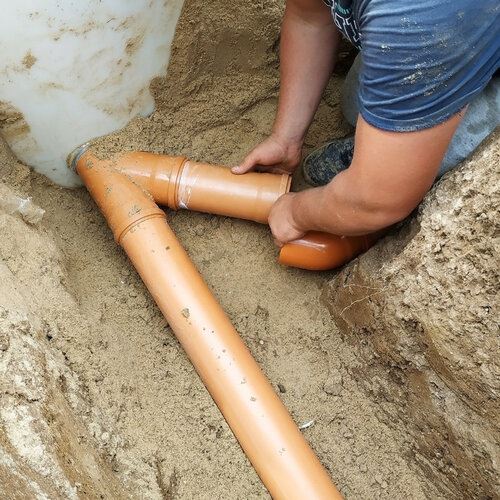The Dangers of Damaged Sewer Lines
Well, who pays for sewer line repairs? That is a common question and often one of the biggest concerns for homeowners. Is sewer line repair covered by homeowners’ insurance? For a homeowner, electrical and plumbing repairs can get expensive, and both are necessities for any household.
A damaged sewage system can cause destruction to floors, furniture, walls, and personal belongings. Sometimes, adding to those expenses is the expense and inconvenience of being displaced during a sewer line repair.
It would be nice to know that all that expense isn’t going to come out of your household budget, right? Sadly, sewer line repair or replacement is typically not included in the standard homeowner insurance policy. However, some homeowner insurance providers do offer add-ons to the policy for damages from sewer or water backup. It may be worth the added expense, which is something each homeowner needs to determine.
How do I know if my main sewer line is clogged?
As a homeowner, it is imperative that you keep watch over important things in and around your home. Things like sewer line repair is important, so a policy of sooner rather than later and noticing a blocked sewer line is essential for your home. There are four warning signs of a blocked or clogged main sewer line you can keep in mind.
If you have multiple backed-up drains such as any of the following, you probably need sewer line repair or replacement:
- Bathtub
- Shower
- Sinks
- Toilets
If you notice sewage standing or draining from the sewer cleanout, you need sewer line repair or replacement. The sewer cleanout is a pipe directly connected to the main sewer line of your home. This allows a plumber to get direct access for clearing most blockages. This sewer cleanout is typically found just outside the house or in a basement and will be round or rectangular with a cap over it.
If the main sewer line is clogged, the sewage and wastewater is sitting in the pipes because it can’t escape and flow on through the sewer line, so it finds other ways to escape. This is usually a secondary drain which you will find coming up in a floor drain or backing up in a shower or tub, drains that are close to the floor and is an indication you need sewer line repair or replacement
When water is backing up in random places, like flushing the toilet causes water to back up into a shower or tub in the bathroom, or the tub fills up when the washing machine drains, you probably will needsewer line repair or replacement.
How do I unclog my main sewer line?
First, when you aren’t sure how to unclog the main sewer line, try some home remedies first. A mixture of 1/3 cup of vinegar and 1/3 cup of baking soda can be poured into each drain and left to sit for three to five minutes. Then pour hot water into the drain. This will often break up any grease, grime, and hair that may be in the drains.
Can I snake my own sewer line?
Yes, if that process doesn’t clear the sewer line, then follow these steps using an auger or plumber’s snake:
Step 1: Loosen the drain pipe cap.
Step 2: Feed the auger or plumber’s snake cable into the drainpipe by turning the handle
Step 4: The cable will stop when it hits the clog. Keep forcing the cable so it will push the clog on through, or when you pull it out of the drain, the clog mass may be on the end of the cable.
Step 5: With the outdoor water hose in the pipe, turn the water on and slowly pull the cable or snake out.
Step 6: Wash the cable or snake off with the outside water hose, replace the cap.
If this doesn’t get your drain clear, you’ll need to call a professional plumber for sewer line repair or replacement.
How do you repair a broken sewer line?
Determining the difference between a clogged drain or a broken sewer line can be difficult. Both can emit a foul odor, but a broken sewer line can create health issues. The sooner you can determine it is a sewer line problem and get sewer line repairs done, the better. There are four steps toward getting sewer lines cleared or sewer line repairs made:
Unclog the Drain
There are several reasons a drain or sewer line becomes clogged. The common causes are hair, kitchen grease and oil, and soap scum. When all of this accumulates, it can be eliminated with a basic household plunger or a plumber’s snake sometimes, if the clog is small and in the drain line. Sometimes, it is bigger clog and requires a plumber’s snake or auger. If you’re unable to get the clog cleared yourself, you’ll need to call a professional plumber who will either get the clog cleared or advise you that you need sewer line repair or replacement.
Locate the Pipe
Knowing the location of the sewer line is needed to either unclog or have the sewer line repaired. This may require gaining access to the basement or crawl space under the house. For a home with a slab foundation, it can be more challenging to find the clogged pipe, which will require a professional plumber. Once they have identified where the clogged pipe is, they can proceed with either a sewer line repair or replacement.
Evaluate any Damage
A professional plumber can help assess what sewer line damage exists and determine how to clear any clogs or tell you what sewer line repairs are needed.
Sewer Line Repair or Replacement
Sometimes with a broken sewer line, repairing the pipe is possible. Sometimes the line is damaged so badly that replacing it is the only option, a common occurrence with older homes with mature trees around. A new technology called trenchless sewer line replacement is a less invasive method that replaces the existing broken sewer line without all the digging or jackhammering. It forms a new pipe within the broken pipe and can last up to 50 years or longer.
How long does it take to repair a broken sewer line?
Most sewer line repairs can be done within a few hours. Depending on the location and severity of the broken sewer line, repairs can take three to five days or longer. Can you repair your own sewer line? Yes, you can, but you’ll have no guarantee if there are any issues later on. Doing your own sewer line repair or replacement is possible, but you should understand that it is dirty and hard work. And if you dig in the wrong area, you could cause more damage.
How do I find the sewer line in my yard?
It is imperative to identify where the sewer lines are located before you have a sewer line problem. Four suggestions on how to find your sewer line are:
This should be obvious, but when you’re buying a home, there is a lot of activity going on and asking these simple questions isn’t always on your mind. If you are selling your home, make it a point to provide this information to the realtor and/or the buyer.
If your home has a septic tank, follow the sewer lines coming out of your home. This should take you to the septic tank.
- Check the Local Municipality
A trip to the local municipality offices and request a copy of the plat showing all of the underground lines.
Check the basement or crawlspace for where the drain line exits. Once you find one pipe and determine it is a drain pipe, follow that pipe (should be a larger pipe) until it exits. Then follow it out past your home should take you to the sewer line.

A Final Word of Caution
So, you find you have a broken sewer line, is a broken sewer line dangerous? Yes! A broken sewer pipe can release harmful bacteria such asE. coli and salmonella, even pinworms. These are things that can affect the digestive tract, possibly infecting your family with amoebiasis, cholera, hepatitis A, or jaundice from the bacteria contained in raw sewage.
